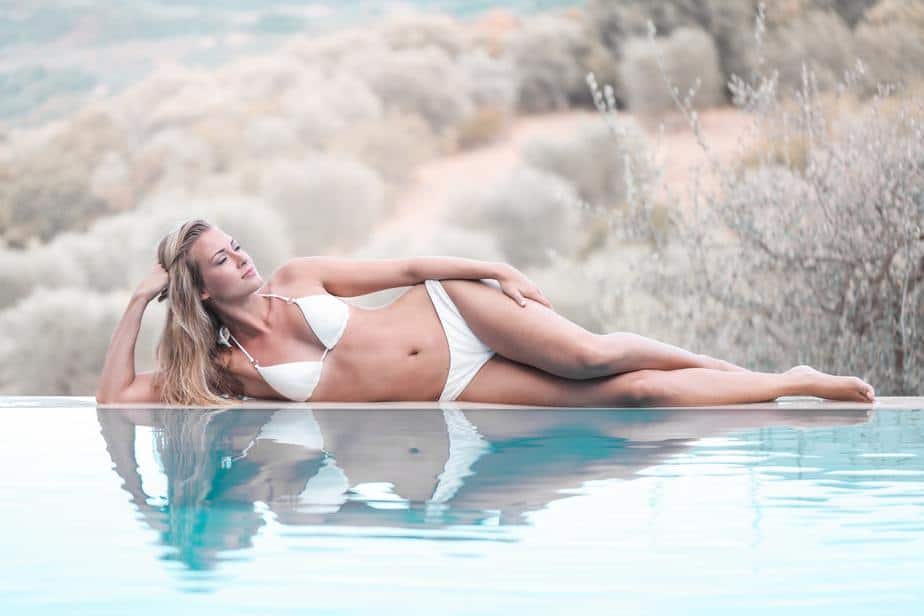With summer fast approaching, it’s about time to start heading to the pool or beach again and for that you need the right swimwear. Your choice of swimwear can help accentuate the features of your body and make you look your best, or it can fit you poorly and make you look unflattering.
In the search for the perfect swimwear, you may have come across various options like bikinis, tankinis, swimsuits, and so on. You might be wondering what differences there are, if any, and which one you should pick.
Depending on where you’re from, the term swimsuit or bathing suit typically refer to a one piece suit, whereas the bikini refers to a two piece suit. The line is blurred with the two piece tankini which provides basically as much skin coverage as a one piece suit.
Which one is “better” depends on what your goals are. One piece swimsuits naturally provide more skin coverage which is good if you want to show less skin and get extra UV protection. Bikinis are great for showing off the body but offer little UV protection and require much more sunscreen. Tankinis are versatile because you can mix and match the top and bottom, however one problem is that the top can sometimes ride up.
Unfortunately, even if you know these facts, it doesn’t help you find the best type of swimwear for your body type. That’s why in this article, we want to go on a deep dive into the pros and cons of swimsuits vs. bikinis so that you can make the most informed choice.
Is a bikini a type of swimsuit?
In this article, we will be using the word “swimsuit” generally to refer to a one piece swimsuit, though I have heard some people interchangeably use “swimsuit” to mean “swimwear”. I have also heard people use “swimsuit” interchangeably with “bathing suit”, however I feel that “bathing suit” refers to a specific type of suit designed for lounging around (it may even be frilly and thus not good for swimming), whereas a bona fide swimsuit is no-nonsense and can be used for swimming laps.
If you believe that the word “swimsuit” can be used interchangeably with “swimwear”, then yes, a bikini is a type of swimsuit. As mentioned, bikinis are two piece suits whereas other swimsuits or bathing suits are one piece. Since both bikinis and swimsuits are designed for use in the water, they must cling onto your body tightly so as not to float away.
People often use the term bathing suit interchangeably with a swimsuit, but in my opinion there are some slight differences. For instance, there are some bathing suits that are clearly not designed for swimming, but rather just for lounging around in a hot tub or in calmer waters. If you tried swimming with these bathing suits, they would probably fall off or expose too much of your body that you want covered.
To be fair, one could argue the same about bikinis. If you tried swimming laps or doing some water sport in a bikini or a tankini, there is a good chance that the top would simply fall off. I’m sure the fellas would appreciate that, but it’s very embarrassing for the woman.
Thus, if you care about performance and being able to swim without worry, then a one piece swimsuit is your best option. If you care more about looking your best and showing off your skin (and don’t really plan on swimming) then bikinis are the better option. But whatever you don’t, don’t wear workout clothes to go swimming; that’s the worst option of all.
Advantages of wearing a swimsuit

More skin coverage
The most obvious advantages that a swimsuit has over a bikini is its coverage. Covering most of the torso, swimsuits provide excellent UV protection whereas bikinis provide nearly none. This also means less sunscreen needed, and less chances of getting sunburned.
Another consideration is in regards to modesty. If you don’t want to get ogled by all the guys, covering up more skin will keep you looking a bit more modest. That said, you can still look good, but the goal here is that you don’t want to show so much skin that nothing is left to the imagination.
Yet another advantage of covering up is that you can cover up any “imperfections” on your body you deem unacceptable. Do you think you’re too large or skinny? Do you have scars or a condition you don’t want people asking questions about? Or maybe you have a tattoo that you are now embarrassed to show off. No worries, you can simply cover it up with a swimsuit in the meantime.
Furthermore, if you are a Muslim woman and want to spend some time in the water, you could wear a burkini. Burkinis are like burkas that are designed for the water. They provide total coverage which is great both for religious reasons and for practical reasons like UV protection or looking modest.
Less chance of a wardrobe malfunction
One issue that two piece swimsuits have is that they are not as secure on your body as a one piece suit is. You can sometimes have embarrassing moments like the top falling off or even, God forbid, the bottom falling off.
Even if you don’t lose a piece, there is always that fear in the back of your mind that maybe you could lose a piece. Also, even if the two piece swimsuit stays on your body, there is still a chance of the bra slipping a bit, forcing you to frequently adjust.
Wardrobe malfunctions are less likely to occur for bikini wearers if they only ever stay on the beach. But, the second you get into the water, things are less likely to stay on your body. The swimsuit solves that by suitably covering up much of your torso so that everything is kept in one tight package (but sometimes they can be a bit too tight).
Thus, if you plan on doing some open water swimming or any sort of water sport, you had best stick with a swimsuit instead of a bikini.
Less likely to lose it
You might decide on wearing a swimsuit for the very practical reason of not wanting to worry about losing any half of a bikini. We’ve already discussed the risks of wardrobe malfunctions with bikinis, but here we are referring to the frustration they can cause when packing for travel.
For bikinis, it’s possible that you could have trouble finding either the top or bottom half depending on how you packed your swimwear. You could also easily lose it after washing it and leaving it out to dry and forgetting where you put one of the pieces.
To be honest, I’m having trouble thinking of examples of how people lose their stuff because that’s how things get lost in the first place; you aren’t sure what the heck happened but now it’s gone. Either way, thinking about it logically: two things to keep track of is more than one thing, so you are twice as likely to lose the swimwear with two pieces.
If you are the kind of person to misplace things all the time, the swimsuit is the better option.
Advantages of wearing a bikini

Get the best tan
Few things are as sexy as a girl with a nice bikini tan, and the best way to do that is to soak up a whole lot of sun while wearing a bikini. While this sounds idyllic, you have to be careful not to expose your skin to too much sun which could result in sunburned and aged skin.
So before you decide to subject yourself to a bunch of harmful UV rays, you need to know how to protect your skin while wearing a bikini so you can get a tan safely.
First, understand that it’s a long process. Don’t think you can just wear a bikini, stay out in the sun for a few hours, and come back with a perfect tan in one day. That’s a great way for you to look like a tomato and to have your skin painfully peel off. No, what you need to do is to gradually expose yourself to more sunlight over multiple days.
Second, 30 minutes before you even go out into the sun, you need to apply a broad spectrum sunscreen with an SPF-15 or higher rating to all of your exposed skin. This lets the sunscreen soak into your skin. Remember to apply it everywhere, and that means behind your neck, behind your ears, behind your knees, between your fingers and toes, and so on.
What a broad spectrum sunscreen does is protect your skin from both of the sun’s UVA and UVB rays, which causes premature aging and cancer respectively. Not all sunscreens are broad spectrum; some only protect you from UVB rays (the cancer causing one) but not UVA rays (rapidly age your skin). Get one that protects you from both, especially if you plan on tanning in a bikini.
The SPF rating refers to how much of the total UV rays are blocked. If you burn easily, get one with a higher SPF rating such as 30 or 50. That said, if your skin doesn’t burn easily, then an SPF15 sunscreen is adequate.
Note: SPF stands for sun protection factor. Typically products with an SPF rating start at 15 and can go up to 100. There seems to be a big difference between an SPF-15 and SPF-100 product, but in terms of percentage points, there isn’t. An SPF-15 product can already block 94% of total UV rays, and an SPF-100 sunscreen can block 99%. It’s up to you to determine if that little bit of protection is worth the extra cost.
Lastly, remember to frequently reapply sunscreen. Read the label for how often you should do it. Some might last longer than others, but in general, expect to reapply it every 30 to 45 minutes. You might even have to reapply it earlier if your skin directly touches a lot of surfaces, such as a towel or chair or other people’s hands, as this can rub off the sunscreen.
This is a major downside of wearing bikinis – you will go through so many bottles of sunscreen. But that’s what it takes to stay safe and get a sexy tan, so if that’s what you want, then it will be worth it.
Show off your bod
While you’re getting that nice tan, you can also enjoy the attention of everyone in your vicinity. Bikinis are a bold fashion statement, and not every woman is comfortable wearing one in front of strangers. If you’ve got a nice body, there’s nothing wrong with showing off what you got while you still got it.
Flaunt your curves unashamedly and let the bikini accentuate these aspects of your physique. It’s even better if you have a toned midsection. Why would you cover up all of your hard work by wearing a one piece swimsuit? Girl, if you’ve got abs, show them off! A bikini is a fantastic way to do that.
Even if you aren’t a hardbody, that’s fine. Bikinis can make you look sexy regardless of your shape and size. They can go a long way in helping you build confidence, feel sexy, and improve your body image. If you love being the center of attention, wear a bikini and soak up everyone’s gaze.
Enjoy maximum comfort
What can we say, being practically naked is very liberating. Often the clothes that feel the most comfiest are the ones that make you feel like you aren’t even wearing anything, but in the case of the bikini, you practically aren’t.
In fact, any discomfort you might be feeling probably has to do with feeling self-conscious. Obviously, a bikini is obviously very revealing, so you need to learn how to be comfortable in your own skin. Once you are, then it’s very liberating both physically and mentally, and that’s a great feeling.
Parting words
When you are searching for a new swimsuit, you need to decide if you will be going with a one piece swimsuit or a two piece one such as a bikini or tankini. Which one you decide to choose can depend on various factors.
For example, are you comfortable with showing off your body? Do you have any blemishes you wish to hide? Are you not as fit as you’d like, so you want to cover up? Are you worried about getting sunburned or having a wardrobe malfunction? Do you plan on swimming laps? If these are the kinds of questions you’re asking, then a one piece swimsuit is probably your best option.
On the other hand, are you proud of your body? Did you train and diet for the summer, and now you want to show off your hard work? Do you want to get a nice tan? Do you want to look and feel as sexy as you can, as well as feel the most comfortable? Then you might be better off with a bikini.
Whenever we compare two or more types of products, there is rarely ever a clear winner. In the case of a swimsuit vs bikini, it just depends on what you want. The “better” one is the one you’re happier with as long as you’re aware of the downsides, and don’t let anyone tell you otherwise.


